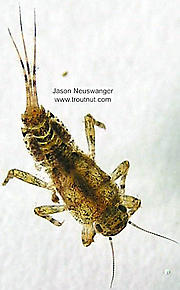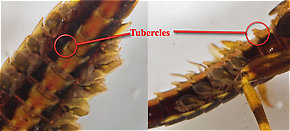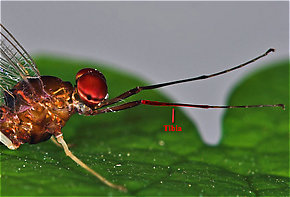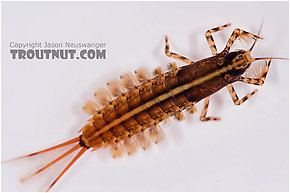Blog & Latest Updates
Fly Fishing Articles
Insects by Common Name


Animal Phylum Arthropoda (Arthropods)
Taxonomic Navigation -?-
Kingdom
Animalia (Animals)
» Phylum Arthropoda (Arthropods)
| Class in Arthropoda | ||
| ArachnidaMites and Spiders | 0 | 1 |
| CollembolaSpringtails | 0 | 0 |
| Crustacea-MalacostracaCrayfish, Scuds, and Sowbugs | 0 | 10 |
| Crustacea-Maxillopoda | 0 | 0 |
| InsectaInsects | 0 | 114 |
Common Name
| Match | Common Name |
| Arthropods |
This is page 28 of specimens of Arthropoda. Visit the main Arthropoda page for:
- The behavior and habitat of Arthropoda.
- 122 underwater pictures of Arthropoda.
Pictures of 1244 Arthropod Specimens:
Chimarra (Little Black Sedges) Caddisfly Larva View 4 Pictures
View 4 Pictures
 View 4 Pictures
View 4 PicturesCollected March 1, 2004 from unknown in Wisconsin
Added to Troutnut.com by Troutnut on January 25, 2006
Added to Troutnut.com by Troutnut on January 25, 2006
Caenis (Angler's Curses) Mayfly Nymph View 4 PicturesI confirmed the identity of this nymph by looking at it under a microscope to be certain of the shape of its gills and head.
View 4 PicturesI confirmed the identity of this nymph by looking at it under a microscope to be certain of the shape of its gills and head.
 View 4 PicturesI confirmed the identity of this nymph by looking at it under a microscope to be certain of the shape of its gills and head.
View 4 PicturesI confirmed the identity of this nymph by looking at it under a microscope to be certain of the shape of its gills and head.Collected January 31, 2004 from unknown in Wisconsin
Added to Troutnut.com by Troutnut on January 25, 2006
Added to Troutnut.com by Troutnut on January 25, 2006
Ephemerella invaria (Sulphur Dun) Mayfly Nymph View 4 Pictures
View 4 Pictures
 View 4 Pictures
View 4 PicturesCollected January 13, 2004 from the Namekagon River in Wisconsin
Added to Troutnut.com by Troutnut on January 25, 2006
Added to Troutnut.com by Troutnut on January 25, 2006
Ephemerella aurivillii Mayfly Nymph View 4 Pictures
View 4 Pictures
 View 4 Pictures
View 4 PicturesCollected February 5, 2004 from unknown in Wisconsin
Added to Troutnut.com by Troutnut on January 25, 2006
Added to Troutnut.com by Troutnut on January 25, 2006
Ephemerella invaria (Sulphur Dun) Mayfly Nymph View 4 PicturesI looked at this small Ephemerella nymph very carefully under a microscope. It as no abdominal tubercles (
View 4 PicturesI looked at this small Ephemerella nymph very carefully under a microscope. It as no abdominal tubercles ( Tubercle: Various peculiar little bumps or projections on an insect. Their character is important for the identification of many kinds of insects, such as the nymphs of Ephemerellidae mayflies.) and 1-banded tibiae (
Tubercle: Various peculiar little bumps or projections on an insect. Their character is important for the identification of many kinds of insects, such as the nymphs of Ephemerellidae mayflies.) and 1-banded tibiae ( Tibia: A middle segments in the leg of an insect, located between the femur and the tarsus.). I think just a very early instar (Instar: Many invertebrates molt through dozens of progressively larger and better-developed stages as they grow. Each of these stages is known as an instar. Hard-bodied nymphs typically molt through more instars than soft-bodied larvae.) invaria nymph.
Tibia: A middle segments in the leg of an insect, located between the femur and the tarsus.). I think just a very early instar (Instar: Many invertebrates molt through dozens of progressively larger and better-developed stages as they grow. Each of these stages is known as an instar. Hard-bodied nymphs typically molt through more instars than soft-bodied larvae.) invaria nymph.
 View 4 PicturesI looked at this small Ephemerella nymph very carefully under a microscope. It as no abdominal tubercles (
View 4 PicturesI looked at this small Ephemerella nymph very carefully under a microscope. It as no abdominal tubercles (
A few (not all) of the abdominal tubercles on this Ephemerella needhami nymph are circled. They are especially large in this species.

The tibia of this Isonychia bicolor mayfly spinner is highlighted in red.
Collected February 7, 2004 from unknown in Wisconsin
Added to Troutnut.com by Troutnut on January 25, 2006
Added to Troutnut.com by Troutnut on January 25, 2006
Baetidae (Blue-Winged Olives) Mayfly Nymph View 4 PicturesThis Baetis nymph is quite a bit larger than any of the others I found in winter 2004. Abdomen segment 5 is only slightly pale while 9 and 10 are quite pale. The tail is banded at the tip. Its body measures about 9mm long. It's much larger than the other Baetis specimens I collected, and it has quite well-developed wingpads.
View 4 PicturesThis Baetis nymph is quite a bit larger than any of the others I found in winter 2004. Abdomen segment 5 is only slightly pale while 9 and 10 are quite pale. The tail is banded at the tip. Its body measures about 9mm long. It's much larger than the other Baetis specimens I collected, and it has quite well-developed wingpads.
It's most likely a mature nymph from a very early-hatching brood. It comes from the headwaters of a very small, very spring-fed Lake Superior tributary, which wasn't at all frozen despite very frigid temperatures and 3 feet of snow on the ground.
 View 4 PicturesThis Baetis nymph is quite a bit larger than any of the others I found in winter 2004. Abdomen segment 5 is only slightly pale while 9 and 10 are quite pale. The tail is banded at the tip. Its body measures about 9mm long. It's much larger than the other Baetis specimens I collected, and it has quite well-developed wingpads.
View 4 PicturesThis Baetis nymph is quite a bit larger than any of the others I found in winter 2004. Abdomen segment 5 is only slightly pale while 9 and 10 are quite pale. The tail is banded at the tip. Its body measures about 9mm long. It's much larger than the other Baetis specimens I collected, and it has quite well-developed wingpads. It's most likely a mature nymph from a very early-hatching brood. It comes from the headwaters of a very small, very spring-fed Lake Superior tributary, which wasn't at all frozen despite very frigid temperatures and 3 feet of snow on the ground.
Collected February 5, 2004 from Schacte Creek, Bayfield County in Wisconsin
Added to Troutnut.com by Troutnut on January 25, 2006
Added to Troutnut.com by Troutnut on January 25, 2006
Paraleptophlebia (Blue Quills and Mahogany Duns) Mayfly Nymph View 4 PicturesLooking at this one under the microscope, I noted that is has untracheated gills which fork 1/3 of the way from the base and postero-lateral (Lateral: To the side.) spines on abdominal segment 9
View 4 PicturesLooking at this one under the microscope, I noted that is has untracheated gills which fork 1/3 of the way from the base and postero-lateral (Lateral: To the side.) spines on abdominal segment 9
 View 4 PicturesLooking at this one under the microscope, I noted that is has untracheated gills which fork 1/3 of the way from the base and postero-lateral (Lateral: To the side.) spines on abdominal segment 9
View 4 PicturesLooking at this one under the microscope, I noted that is has untracheated gills which fork 1/3 of the way from the base and postero-lateral (Lateral: To the side.) spines on abdominal segment 9Collected February 7, 2004 from unknown in Wisconsin
Added to Troutnut.com by Troutnut on January 25, 2006
Added to Troutnut.com by Troutnut on January 25, 2006
Isonychia bicolor (Mahogany Dun) Mayfly Nymph View 5 Pictures
View 5 Pictures
 View 5 Pictures
View 5 PicturesCollected April 19, 2006 from the Beaverkill River in New York
Added to Troutnut.com by Troutnut on April 21, 2006
Added to Troutnut.com by Troutnut on April 21, 2006
Teloganopsis deficiens (Little Black Quill) Mayfly Nymph View 6 PicturesThis nymph has tiny, barely detectable tubercles (
View 6 PicturesThis nymph has tiny, barely detectable tubercles ( Tubercle: Various peculiar little bumps or projections on an insect. Their character is important for the identification of many kinds of insects, such as the nymphs of Ephemerellidae mayflies.) on its abdominal segments, and I could not find the maxillary palpi. I have tentatively guessed that it is Serratella deficiens.
Tubercle: Various peculiar little bumps or projections on an insect. Their character is important for the identification of many kinds of insects, such as the nymphs of Ephemerellidae mayflies.) on its abdominal segments, and I could not find the maxillary palpi. I have tentatively guessed that it is Serratella deficiens.
 View 6 PicturesThis nymph has tiny, barely detectable tubercles (
View 6 PicturesThis nymph has tiny, barely detectable tubercles (
A few (not all) of the abdominal tubercles on this Ephemerella needhami nymph are circled. They are especially large in this species.
Collected June 9, 2005 from the Bois Brule River in Wisconsin
Added to Troutnut.com by Troutnut on May 26, 2006
Added to Troutnut.com by Troutnut on May 26, 2006
Male Maccaffertium modestum (Cream Cahill) Mayfly Dun View 6 Pictures
View 6 Pictures
 View 6 Pictures
View 6 PicturesCollected June 4, 2005 from the Teal River in Wisconsin
Added to Troutnut.com by Troutnut on May 24, 2006
Added to Troutnut.com by Troutnut on May 24, 2006
Top 10 Fly Hatches
Top Gift Shop Designs
Eat mayflies.
Top Insect Specimens
Miscellaneous Sites
Troutnut.com is copyright © 2004-2024 Jason
Neuswanger (email Jason). See my FAQ for information about use of my images.
 privacy policy
privacy policy
